Does acupressure therapy decrease blood pressure in hypertensive elderly?
DOI:
https://doi.org/10.54832/phj.v6i2.919Keywords:
elderly, hypertension, blood pressure, acupressureAbstract
ntroduction: Hypertension is a high blood pressure condition often referred to as the "silent killer" as it is frequently asymptomatic but can lead to a range of serious health complications, including heart disease and stroke. The prevalence of hypertension continues to rise worldwide, with projections of reaching 29% of the adult population by 2025. To control hypertension, complementary therapies such as acupressure are emerging as a supportive complement to the management of high blood pressure, especially for the elderly, to improve their quality of life and ease the burden on the healthcare system.
Objectives: to analyze the effect of acupressure therapy on blood pressure in hypertensive elderly.
Methods: Pre-Experimental Design, with a One-Group Pretest-Posttest Design.
Results: The results showed a decrease in average systolic blood pressure by 24.08 mmHg, from 148.08 mmHg in the pre-test to 124.00 mmHg in the post-test, with a p value of 0.002. In addition, there was a decrease in mean diastolic blood pressure by 11.83 mmHg, from 85.83 mmHg in the pre-test to 74.00 mmHg in the post-test, with a value of (p value 0.013). These results indicate that acupressure therapy has a significant effect on reducing systolic and diastolic blood pressure in elderly hypertension.
Conclusions: These findings support using acupressure as a complementary therapy to assist in managing hypertension in the elderly, potentially improving their quality of life and reducing the burden of hypertension-related health services.
Downloads
References
Dinas Kesehatan Kabupaten Gianyar. (2017). Profil Kesehatan Kabupaten Gianyar Tahun 2016. 1–187.
Dinas Kesehatan Provinsi Bali. (2022). Profil Kesehatan Provinsi Bali 2021. 2022.
Haldar, R. N. (2013). Global Brief on Hypertension: Silent Killer, Global Public Health Crisis. Indian Journal of Physical Medicine and Rehabilitation, 24(1), 2–2. https://doi.org/10.5005/ijopmr-24-1-2
Hartono, W. I. R. (2012). Akupresur untuk Berbagai Penyakit (A. Hartono (ed.); 1st ed.). CV Andi Offest.
Indonesia, K. K. (2019). Laporan Nasional Riskesdas 2018. In Lembaga Penerbit Balitbangkes. : Badan Penelitian dan Pengembangan Kesehatan, Departemen Kesehatan RI.
Peraturan Menteri Kesehatan Repubik Indonesia Nomor 15 Tahun 2018 Tentang Penyelenggaraan Layanan kesehatan Tradisional Komplementer, 430 (2018).
Maryati; Pertiwi, A. L. (2022). Terapi Akupressur Menurunkan Tekanan Darah Pada Lansia Hipertensi di Tresan Werdha Jakarta. Jurnal Ilmiah Avicenna, 17(8), 14–20. https://doi.org/10.56304/s0040363622080021
Nur Dina Kamelia, Anita Dwi Ariyani, & Rudiyanto, R. (2021). Terapi Akupresur pada Tekanan Darah Penderita Hipertensi: Studi Literatur. Nursing Information Journal, 1(1), 18–24. https://doi.org/10.54832/nij.v1i1.162
Perhimpunan Dokter Hipertensi Indonesia PDHI. (2021). Perhimpunan Dokter Hipertensi indonesia. I-Hefcard.Com, 118.
Riskesdas, T. (2018). Laporan Provinsi Bali RISKESDAS 2018. In Badan Penelitian dan Pengembangan Kesehatan. Badan Penelitian dan Pengembangan Kesehatan (LPB).
Sugiono. (2021). Metode Penelitian Kuantitatif, Kualitatif, dan R&D (2nd ed.). Alfabeta.
Suwarini, N. M., Sukmandari, N. M. A., & Wulandari, M. R. S. (2021). Pengaruh Pemberian Terapi Akupresur terhadap Tekanan Darah Lansia di Puskesmas Kediri I Tabanan. Jurnal Surya Medika, 7(1), 243–247. https://doi.org/10.33084/jsm.v7i1.2181
WHO. (2023). Global report on hypertension. In Universitas Nusantara PGRI Kediri (Vol. 01).

















